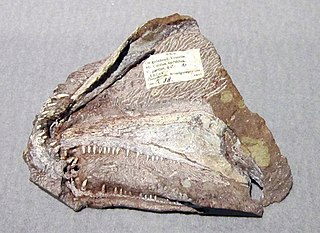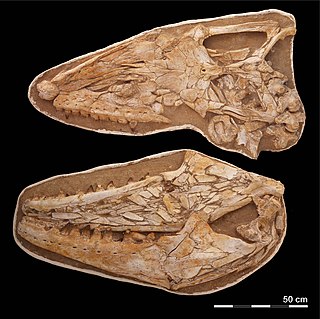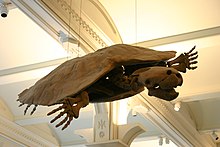
Podocnemididae is a family of pleurodire (side-necked) turtles, once widely distributed. Most of its 41 genera and 57 species are now extinct. Seven of its eight surviving species are native to South America: the genus Peltocephalus, with two species, only one of which is extant ; and the genus Podocnemis, with six living species of South American side-necked river turtles and four extinct. There is also one genus native to Madagascar: Erymnochelys, the Madagascan big-headed turtle, whose single species E. madagascariensis.

Baru, sometimes referred to as the cleaver-headed crocodile, is an extinct genus of Australian mekosuchine crocodilian. Its fossils have been found from various Late Oligocene and Miocene localities from across the Northern Territory and Queensland, indicating that Baru was a common genus during the late Paleogene and early Neogene. Three species are recognized, B. darrowi, B. iylwenpeny, and B. wickeni.

Stupendemys is an extinct genus of freshwater side-necked turtle, belonging to the family Podocnemididae. It is the largest freshwater turtle known to have existed, with a carapace over 2 meters long. Its fossils have been found in northern South America, in rocks dating from the Middle Miocene to the very start of the Pliocene, about 13 to 5 million years ago. Male specimens are known to have possessed bony horns growing from the front edges of the shell and the discovery of the fossil of a young adult shows that the carapace of these turtles flattens with age. A fossil skull described in 2021 indicates that Stupendemys was a generalist feeder.

The Pleurodira are one of the two living suborders of turtles, the other being the Cryptodira. The division between these two suborders represents a very deep evolutionary divide between two very different types of turtles. The physical differences between them, although anatomical and largely internal, are nonetheless significant, and the zoogeographic implications of them are substantial. The Pleurodira are known more commonly as the side-necked turtles and the name Pleurodira quite literally translates to side neck, whereas the Cryptodira are known as hidden-necked turtles. The Pleurodira turtles are currently restricted to freshwater habitats in the Southern Hemisphere, largely to Australia, South America, and Africa. Within the Pleurodira, three living families are represented: Chelidae, also known as the Austro-South American side-necked turtles, the Pelomedusidae, also known as the African mud terrapins, and the Podocnemididae, also known as the American side-neck river turtles. However, they were cosmopolitan clade during the Cretaceous and most of the Cenozoic, and even occurred in marine environments around the world.

The Big-headed Amazon River turtle, also known as the big-headed sideneck, is a species of turtle in the family Podocnemididae.

Plesiotylosaurus, meaning "near Tylosaurus", is an extinct genus of marine lizard belonging to the mosasaur family. It is classified as part of the Mosasaurinae subfamily, alongside genera like Mosasaurus and Prognathodon. The genus contains one species, Plesiotylosaurus crassidens, recovered from deposits of Middle Maastrichtian age in the Moreno Formation in California.

Eilenodon is an extinct genus of rhynchocephalian reptile from the Late Jurassic Morrison Formation of western North America, present in stratigraphic zone 4. The only known species of this genus is Eilenodon robustus. It was a member of a group of rhynchocephalians called the eilenodontines, which were large, herbivorous members of Rhynchocephalia, the order of reptiles which contains the modern tuatara (Sphenodon). The generic name "Eilenodon" is Greek for "packed teeth", in reference to its closely packed teeth. The specific name, "robustus", refers to the strong build of the jaws.

Daemonosaurus is an extinct genus of possible theropod dinosaur from the Late Triassic of New Mexico. The only known fossil is a skull and neck fragments from deposits of the latest Triassic Chinle Formation at Ghost Ranch. Daemonosaurus was an unusual dinosaur with a short skull and large, fang-like teeth. It lived alongside early neotheropods such as Coelophysis, which would have been among the most common dinosaurs by the end of the Triassic. However, Daemonosaurus retains several plesiomorphic ("primitive") traits of the snout, and it likely lies outside the clade Neotheropoda. It may be considered a late-surviving basal theropod or non-theropod basal saurischian, possibly allied to other early predatory dinosaurs such as herrerasaurids or Tawa.

Ymeria is an extinct genus of early stem tetrapod from the Devonian of Greenland. Of the two other genera of stem tetrapods from Greenland, Acanthostega and Ichthyostega, Ymeria is most closely related to Ichthyostega, though the single known specimen is smaller, the skull about 10 cm in length. A single interclavicle resembles that of Ichthyostega, an indication Ymeria may have resembled this genus in the post-cranial skeleton.
Brontochelys is an extinct genus of podocnemidid from the Miocene of Pakistan. The only species known, B. gaffneyi was classified before in the genus Shweboemys, which is known from the Pliocene of Burma. Brontochelys is represented only by its type specimen BMNH R.8570, a nearly complete skull, which exact locality is unknown but probably comes from the Lower Miocene sediments in the Bugti Hills, in Baluchistan, Pakistan. This skull is different from its relatives like Shweboemys, Lemurchelys and Stereogenys by its large, forward-faced orbits, a large frontal bone that composes most of the dorsal orbit margin and a palatal curved. The name of Brontochelys is formed by the Greek words bronte, "thunder" and chelys, "turtle", in reference to the large size of the skull.

Crocodylus checchiai is an extinct species of crocodile from the Miocene to Pliocene of Libya and Kenya. C. checchiai was named in 1947 based on a skull from the Sahabi Formation. Remains from the lower Nawata Formation in the Turkana Basin of Kenya that were first attributed to the Nile crocodile have now been reassigned to C. checchiai, extending its geographic range. The morphology of the species, in particular the pronounced rostral boss, indicates that it may be the connecting link between African and American species of the genus Crocodylus.

Carbonemys cofrinii is an extinct giant podocnemidid turtle known from the Middle Paleocene Cerrejón Formation of the Cesar-Ranchería Basin in northeastern Colombia. The formation is dated at around 60 to 57 million years ago, starting at about five million years after the KT extinction event.
Caiman brevirostris is an extinct species of caiman that lived during the Late Miocene, around 11.6 million years ago, to the end of the Miocene 5.3 million years ago in Acre and Amazonas, Brazil as well as Urumaco, Venezuela. Several specimens have been referred to the species, but only 3 of them are confidently placed in the species. C. brevirostris was originally named in 1987 on the basis of a single, incomplete rostrum with an associated mandibular ramus that had been found in Acre, Brazil. C. brevirostris is very distinct among Caiman species and caimaninae overall in that it preserves a characteristically short and robust skull that bears blunt posterior teeth that were built to break down harder foods. This was an adaption for durophagy, likely to crush shells of mollusks and clams which were common in the wetlands that C. brevirostris resided in.
Azabbaremys is an extinct genus of bothremydid pleurodiran turtle that was discovered in the Teberemt Formation of Mali. It was described in 2001, based on a skull that had been recovered in an expedition in 1981. The genus consists solely of the type species Azabbaremys moragjonesi. The genus name is derived from Azabbar, a monster in Tamasheq folk stories. The species is named for Morag Jones, a research student who participated in the discovery of the specimen and died in the expedition. Azabbaremys is most closely related to another Paleocene side-necked turtle, Acleistochelys.

Sahonachelys is an extinct genus of pelomedusoid turtle from the Late Cretaceous (Maastrichtian) Maevarano Formation of Madagascar. The genus contains a single species, Sahonachelys mailakavava.

Ultrastenos is an extinct genus of Australian mekosuchine crocodilian that lived during the Late Oligocene in northwestern Queensland, Australia. Following its discovery, it was speculated that Ultrastenos was a slender-snouted animal similar to modern gharials or freshwater crocodiles due to the seemingly abruptly narrowing mandible. However, a later study found that this was a missinterpretation of the fossil specimen and that Ultrastenos instead had a more generalized lower jaw. The same publication also provided evidence that the fossils of Ultrastenos belonged to the same animal previously named "Baru" huberi, adding further evidence to the idea that the animal was short snouted, contrary to the initial hypothesis. Given that "Baru" huberi was named first, the type species of Ultrastenos changed from U. willisi to U. huberi in accordance with the rules of the ICZN. Ultrastenos was a small mekosuchine, measuring upwards of 1.5 m long.

Kyhytysuka is an extinct genus of ophthalmosaurian ichthyosaur from Early Cretaceous Colombia. The animal was previously assigned to the genus Platypterygius, but given its own genus in 2021. Kyhytysuka was a mid-sized ophthalmosaurian with heterodont dentition and several adaptations suggesting that it was a macropredatory vertebrate hunter living in shallow waters. It contains a single species, Kyhytysuka sachicarum.

Amabilis uchoensis is a species of prehistoric pleurodiran turtle from the Late Cretaceous of South America. It is the only species in the genus Amabilis.

Thalassotitan is an extinct genus of large mosasaurs that lived during the late Maastrichtian of the Cretaceous period in what is now Morocco, around 66 million years ago. The only known species is T. atrox, described in 2022 from fossils discovered in the Ouled Abdoun Basin, where many other mosasaurs have been found. It was assigned to the tribe Prognathodontini alongside other mosasaurs like Prognathodon and Gnathomortis. The prognathodontines are separated from other mosasaurs based on their massive jaws and robust teeth.
Peltocephalus maturin is an extinct species of podocnemidid river turtle closely related to the big-headed Amazon River turtle that lived during the Late Pleistocene and Early Holocene in what is now Brazil. P. maturin is known from a singular lower jaw of enormous size, with estimates suggesting its carapace may have reached lengths of around 1.70 m. This would make it one of the largest freshwater turtles in history, comparable in size to the Paleocene podocnemidid Carbonemys and only exceeded by the Miocene podocnemidid Stupendemys. Like its closest relative, it was likely an omnivore, the narrow cutting surface of its lower jaw unsuited for strict herbivory or durophagy.


















